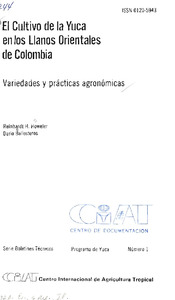El cultivo de la yuca en los Llanos Orientales de Colombia: Variedades y practicas agronomicas
Recommendations are given on the var. and cultural practices used in cassava cultivation in the Colombian Llanos Orientales. Initially, soil acidity and low fertility were believed to be the major constraints; however, trials have indicated that diseases (bacterioses, superelongation, and anthracnose), pests (mites, thrips, mealybugs, and lace bugs), and the long summer season are obstacles more difficult to overcome. Var. should be selected not only for yields and resistance to the above diseases and pests but also for final end use of roots. The most important characteristics (productivity, DM, and HCN content) of 14 var. recommended for the region are indicated. Cutting selection and preparation (3 preplant mixtures indicated) are detailed as well as land preparation, liming, fertilization, and harvest. Cassava can be planted throughout the yr, if soil moisture is adequate; several alternative crop distributions are given with the resp. yields obtained in different trials. The most effective weed, pest, and disease control measures are indicated with emphasis on chemical control. Cassava production costs/ha are also given. (CIAT)

